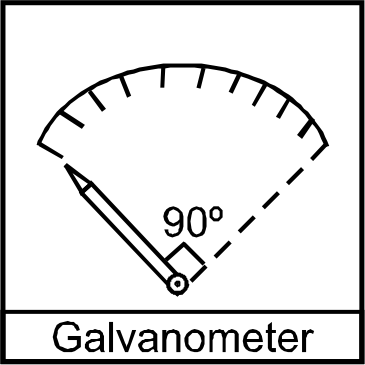A galvanometer of number of turns 175 having 1cm2 area through 1∘ when a current of 1mA is passed. Find magnetic field if torsional constant of spring is 10−6N−m
10−4T
10−3T
10−2T
10−1T
The correct Answer is:B
To solve the problem, we need to find the magnetic field B using the given parameters of the galvanometer. The relationship between the magnetic field, current, number of turns, area, torsional constant, and angular displacement is given by the formula:
B⋅I⋅n⋅A=C⋅θ
Where:
- B = magnetic field
- I = current in amperes
- n = number of turns
- A = area in square meters
- C = torsional constant in N⋅m
- θ = angular displacement in radians
1. Identify the Given Values:
- Number of turns, n=175
- Area, A=1cm2=1×10−4m2 (conversion from cm² to m²)
- Current, I=1mA=1×10−3A (conversion from mA to A)
- Torsional constant, C=10−6N⋅m
- Angular displacement, θ=1∘=π180radians (conversion from degrees to radians)
2. Substitute the Values into the Formula:
Rearranging the formula to solve for B:
B=C⋅θI⋅n⋅A
Substitute the known values:
B=10−6⋅π180(1×10−3)⋅175⋅(1×10−4)
3. Calculate the Denominator:
Calculate I⋅n⋅A:
I⋅n⋅A=(1×10−3)⋅175⋅(1×10−4)=1.75×10−7
4. Calculate the Magnetic Field B:
Now plug this back into the equation for B:
B=10−6⋅π1801.75×10−7
Simplifying this gives:
B=10−6⋅π180⋅1.75×10−7=π18⋅1.75
5. Final Calculation:
Calculate the numerical value:
B≈3.1431.5≈0.001T
Therefore, we can express this as:
B≈10−3T
Conclusion:
The magnetic field B is approximately 10−3T.
- B = magnetic field
- I = current in amperes
- n = number of turns
- A = area in square meters
- C = torsional constant in N⋅m
- θ = angular displacement in radians
- Number of turns, n=175
- Area, A=1cm2=1×10−4m2 (conversion from cm² to m²)
- Current, I=1mA=1×10−3A (conversion from mA to A)
- Torsional constant, C=10−6N⋅m
- Angular displacement, θ=1∘=π180radians (conversion from degrees to radians)
Rearranging the formula to solve for B:
B=C⋅θI⋅n⋅A
B=10−6⋅π180(1×10−3)⋅175⋅(1×10−4)
Calculate I⋅n⋅A:
I⋅n⋅A=(1×10−3)⋅175⋅(1×10−4)=1.75×10−7
Now plug this back into the equation for B:
B=10−6⋅π1801.75×10−7
B=10−6⋅π180⋅1.75×10−7=π18⋅1.75
Calculate the numerical value:
B≈3.1431.5≈0.001T
B≈10−3T
The magnetic field B is approximately 10−3T.
Topper's Solved these Questions
Similar Questions
The coil of a moving coil galvanometer has an effective area of 5×10−2m2. It is suspended in a magnetic field of 2×10−2 Wbm−2.If the torsional constant of the senpension fibre is 4×10−9Nmdeg^(-1). Then find its current sensitivity in degree per microampere
View SolutionA moving coil galvanometer has N numbr of turns in a coil of effective area A, it carries a current I. The magnetic field B is radial. The torque acting on the coil is
View SolutionA moving coil galvanometer has 100 turns and each turn has an area 2.0cm2. The magnetic field produced by the magnet is 0.01T. The deflection in the coil is 0.05 radian when a current of 10mA is passed through it. Find the torsional constant of the suspension wire.
View SolutionA moving coil galvanometer has 100 turns and each turn has an area 2.0cm2. The magnetic field produced by the magnet is 0.01T. The deflection in the coil is 0.05 radian when a current of 10mA is passed through it. Find the torsional constant of the suspension wire.
View SolutionIn a moving coil galvanometer, torque on the coil can be experessed as τ=ki, where i is current through the wire and k is constant . The rectangular coil of the galvanometer having number of turns N , area A and moment of interia I is placed in magnetic field B. Find
(a) k in terms of given parameters N,I,AandB
(b) the torsion constant of the spring , if a current i0 produces a deflection of (π)/(2) in the coil .
(c) the maximum angle through which the coil is deflected, if charge Q is passed through the coil almost instaneously. ( ignore the daming in mechinal oscillations).
View SolutionIn a moving coil galvanometer, torque on the coil can be experessed as τ=ki, where i is current through the wire and k is constant . The rectangular coil of the galvanometer having number of turns N , area A and moment of interia I is placed in magnetic field B. Find
(a) k in terms of given parameters N,I,AandB
(b) the torsion constant of the spring , if a current i0 produces a deflection of (π)/(2) in the coil .
(c) the maximum angle through which the coil is deflected, if charge Q is passed through the coil almost instaneously. ( ignore the daming in mechinal oscillations).
View SolutionIn a moving coil galvanometer, a coil of area πcm2 and 10 windings is used. Magnetic field strength applied on the coil is 1 tesla and torsional stiffness of the torsional spring 6×10−5N.M/rad. A needle is welded with the coil. Due to limited space, the coil (or needle) can rotate only by 90∘. For marking. the 90∘ space is equaly

View SolutionA circular coil of radius 1⋅5cmcarriesacurrentof1⋅5A. If the coil has 25 turns , find the magnetic field at the centre.
View SolutionA moving coil galvanometer has a coil with 175 turns and area 1cm2. It uses a torsion band of torsion constant 10−6N−m/rad. The coil is placed in a magnetic field B parallel to its plane. The coil deflects by 1∘ for a current of 1 mA. The value of B (in Tesla) is approximately.
View SolutionA moving coil galvanometer has a circular coil of area 16cm2 and 30 turns. It is mounted on a torsional spring of spring constant 100 Nm/rad. The coil turns by angle 21∘ when a current 40 mA is passed through it. The magnitude of the uniform magnetic field produced by the permanent magnet inside the galvanometer is _________________T.
[use cos21∘=1516,21∘≈1130 rad]
View Solution
